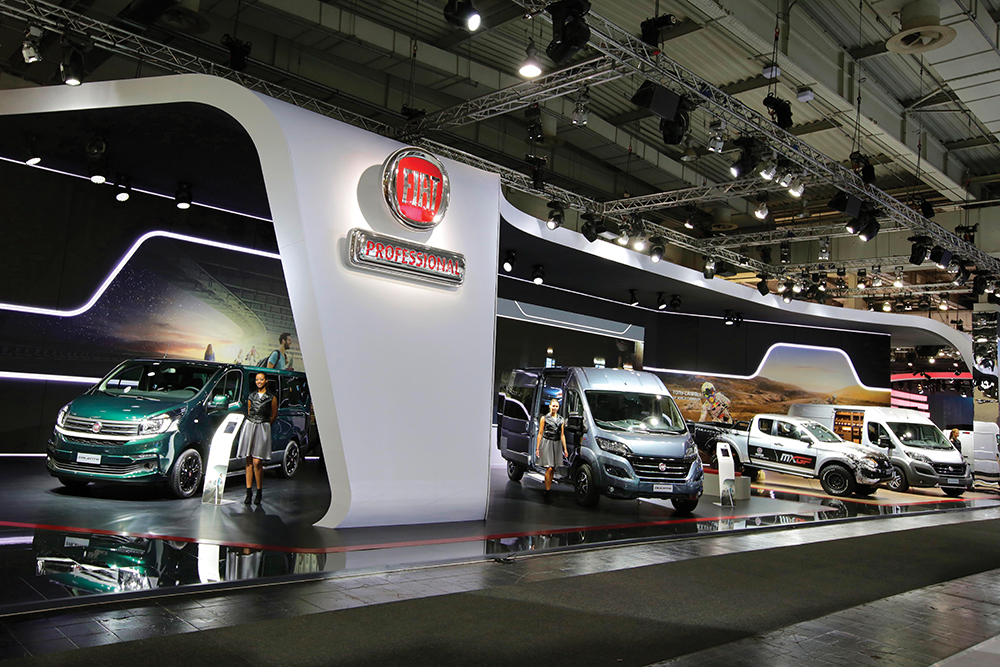Commercial vehicles exhibit their cleaner side

The 66th edition of the Hannover International Motor Show took place from 22-29 September. GreenFleet takes a look at the biggest European exhibition of commercial and industrial vehicles, and puts the spotlight on a few of the more notable light commercials on show.
Fiat Professional
At the biggest European exhibition of commercial and industrial vehicles, Fiat Professional showed its revitalised full line-up in Hannover. With its offerings covering a massive 97 per cent of the market, the Italian brand displayed everything from its new Fiorino city van to the Euro 6-equipped Ducato. The company’s largest offering was also celebrating its 35th anniversary in Germany, and over those three-and-a-half decades, the Ducato has found over 2.9 million customers who like its blend of qualities.
In-between its smallest largest LCV models, Fiat Professional proudly presented its new Fullback pick-up (GreenFleet 97), its new medium-sized Talento as well as a refreshed Doblò Cargo. With a van to suit most needs, all of the 2016 Fiat Professional range is now Euro 6-compliant, with alternative fuels such as CNG also featuring heavily.
The new Crafter was the star of the stand, and with a maximum permitted weight of 5.5 metric tonnes, a larger maximum cargo volume of 18.4m3 and a range of drivetrains, there was a lot to shout about. The ‘International Van of the Year’ jury also agreed, as the latest version of VW’s largest commercial received the 2017 prize.
However, the new electric e-Crafter concept also made an appearance at the 66th running of the IAA show. Although a concept Volkswagen says that the e-Crafter will “already be in customers’ hands by 2017.”
While it has an electric drive system, its cargo area is unimpaired by the powertrain, and there are no changes to the overall dimensions.
With a permitted total weight of 4.2 tonnes, the roadworthy concept uses a 100kW electric motor to power it up to the maximum permitted speed of 50mph. A 312-cell, 43kWh battery pack sits under the load floor, and depending on configuration, gives a range of 125 miles. Subject to sufficient charging current capacity, the batteries can also be charged back up to 80 per cent in 45 minutes. VW also says that the e-Crafter’s design already takes into account future battery developments, which – depending on customer requirements and specification – can be freely configured to enable ranges as large as 250 miles.
Mercedes-Benz Vision Van study
Mercedes-Benz revealed its all-electric Vision Van study in Hannover. The Vision Van has been developed as part of its adVANce initiative, which will see Mercedes-Benz Vans invest approximately €500 million over the next five years for digitalisation, automation and robotics in vans.
The Vision Van combines various innovative solutions for last-mile delivery in urban and suburban environments and is the first van to fully digitally connect all people and processes involved, from the distribution centre to the consignee.
The Vision Van is equipped with a 75kW electric drive and has a range of up to 167 miles (270km). It also features a fully automated cargo space and integrated delivery drones, which will enable delivery of multiple packages to nearby consignees autonomously by air.
The adVANce initiative will look to adapt the Mercedes-Benz Vans offering to meet the needs of its customers’ changing requirements, with a focus on delivering innovative mobility solutions through increased digitalisation and automation.
Hyundai H350 Fuel Cell Concept
Hyundai Motors unveiled a new fuel cell concept in Germany which demonstrated a light commercial vehicle (LCV) application for hydrogen technology. The H350 Fuel Cell Concept has a range of 262 miles (422km): its 175-litre hydrogen tanks takes just under four minutes to fill. It is powered by a 100kW electric motor and 24kWh lithium-ion battery. The H350 has been designed to so that the powertrain does not impact the load areas, meaning it provides 10.5m³ or 12.9m³ of space, depending on wheelbase, or room for a 14-seat passenger compartment. The H350 Fuel Cell concept follows on from Hyundai’s pioneering work on the ix35 Fuel Cell and continues the company’s commitment to hydrogen technology and sustainable transport solutions.







